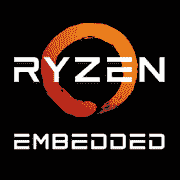AMD Ryzen Embedded R1505G

AMD Ryzen Embedded R1505G: Budget Processor for Basic Tasks. Detailed Review (2025)
Introduction
The AMD Ryzen Embedded R1505G is a processor designed for budget laptops and embedded systems, released in 2025. Despite using the outdated Zen architecture (1st generation) and a 14nm manufacturing process, it remains relevant for entry-level devices. This article will analyze its strengths and weaknesses, applications, and compare it with competitors.
Architecture and Manufacturing Process: Zen on 14nm
CPU Features
- Cores and Threads: 2 cores, 4 threads thanks to SMT (Simultaneous Multithreading).
- Frequencies: Base clock at 2.4 GHz, maximum turbo boost at 3.3 GHz.
- Cache: 4 MB L3, 1 MB L2 (512 KB per core).
- Manufacturing Process: 14nm - an outdated standard for 2025, affecting energy efficiency.
The first-generation Zen architecture provides basic performance but lags behind modern chips based on Zen 3/4 (5-7nm) in speed and efficiency. For instance, the Ryzen 5 5500U (Zen 2, 7nm) is 30% faster in multithreaded tasks.
Integrated Graphics Radeon Vega 3
- Compute Units: 3 Vega cores.
- GPU Frequency: Up to 1000 MHz.
- Capabilities: Supports 4K via HDMI 2.0, H.265 decoding.
This graphics solution is suitable for office applications, video playback, and undemanding games at low settings (for example, Minecraft or CS:GO at 720p). It is not suitable for modern projects like Cyberpunk 2077 or Call of Duty: Warzone.
Power Consumption and TDP: 25W - A Compromise Between Power and Battery Life
- TDP of 25W - higher than that of modern mobile processors (for example, the Intel Core i3-1215U has a TDP of 15W). This implies:
- Laptops with the R1505G require active cooling (fan).
- Higher power consumption reduces battery life.
- Energy-saving Technologies:
- Precision Boost - automatic core overclocking under low load.
- Cool’n’Quiet - frequency reduction during idle periods.
Performance: What Can You Do with the R1505G?
Office Work and Multimedia
- Browser: Comfortable operation with 10–15 tabs in Chrome (without heavy web applications).
- Documents: Microsoft Office, Google Docs, PDF editors - no lags.
- Video: Streaming 4K (YouTube, Netflix), but rendering 1080p in DaVinci Resolve will take 2–3 times longer than on the Ryzen 5 5500U.
Gaming
- eSports:
- Dota 2 - 30–40 FPS at low settings (720p).
- Rocket League - 40–50 FPS (720p).
- Indie Games: Stardew Valley, Hollow Knight - 60 FPS.
Turbo Mode
Under load on 1–2 cores, the frequency increases to 3.3 GHz, providing a 10–15% boost in single-threaded tasks (such as launching applications). However, prolonged heavy workloads may cause throttling due to heat.
Usage Scenarios: Who is the R1505G Suitable For?
1. Students - for studying, working with texts, and Zoom.
2. Office Workers - basic tasks, cloud services.
3. Portable Media Center Users - video watching, streaming.
4. Industrial Systems - terminals, kiosks, IoT devices (thanks to its embedded status).
Not Recommended For:
- Gamers.
- Photographers/Videographers (heavy Photoshop, Premiere Pro).
- Programmers (code compilation, virtualization).
Battery Life: How Long Will the Laptop Last?
- Battery 40–50 Wh: 5–7 hours under mixed load (web surfing, video).
- Energy Saving:
- The “Power Saving” mode in Windows/Linux reduces CPU frequency to 1.8 GHz.
- Disabling Turbo Boost can extend battery life by 15–20%.
Tip: Choose laptops with fast charging (50% in 30 minutes) and a battery capacity of at least 50 Wh.
Comparison with Competitors: AMD, Intel, Apple
AMD Ryzen 3 7320U (Zen 2, 6nm)
- Pros: +40% performance, 15W TDP.
- Cons: Laptops are more expensive ($600–$800).
Intel Core i3-1215U (10nm, Alder Lake)
- Pros: Higher IPC, support for Thunderbolt 4.
- Cons: Pricier by $50–$100.
Apple M1 (5nm)
- Pros: 3–4 times higher performance, 18 hours of battery life.
- Cons: macOS, starting price of $999.
Conclusion: The R1505G does not compare favorably with modern counterparts but wins on price.
Pros and Cons of AMD Ryzen Embedded R1505G
Strengths
- Price: Laptops starting at $400.
- Sufficient performance for basic tasks.
- 4K support via HDMI.
Weaknesses
- Outdated manufacturing process (14nm vs. 5–7nm for competitors).
- No PCIe 4.0 support (only PCIe 3.0).
- Limited upgrade options — the processor is soldered to the motherboard.
Recommendations for Choosing a Laptop
- Type of Device: Budget ultrabooks (Acer Aspire 3, Lenovo IdeaPad 1), Chromebook-like devices running Windows.
- Minimum Specifications:
- 8 GB of RAM (preferably 16 GB for multitasking).
- 256 GB SSD (preferably NVMe).
- IPS screen with a resolution of 1920×1080.
- What to Check Before Buying:
- Presence of active cooling.
- Ports (USB-C, HDMI 2.0).
- Weight (ideally up to 1.5 kg).
Final Conclusion: Who is This Processor Suitable For?
The AMD Ryzen Embedded R1505G is a choice for those seeking a cheap laptop for basic tasks. It can handle office work, online learning, and simple media consumption. However, for gaming, professional software, or extended battery life, consider models with Ryzen 5/7 or Intel Core i5.
Key Benefits:
- Savings of $200–$300 compared to modern counterparts.
- Reliability for embedded systems.
- Minimal performance without experiencing “lags.”
Target Audience: Students, retirees, office workers, companies acquiring devices for kiosks or terminals.
Basic
CPU Specifications
Memory Specifications
GPU Specifications
Benchmarks
Compared to Other CPU
Share in social media
Or Link To Us
<a href="https://cputronic.com/en/cpu/amd-ryzen-embedded-r1505g" target="_blank">AMD Ryzen Embedded R1505G</a>